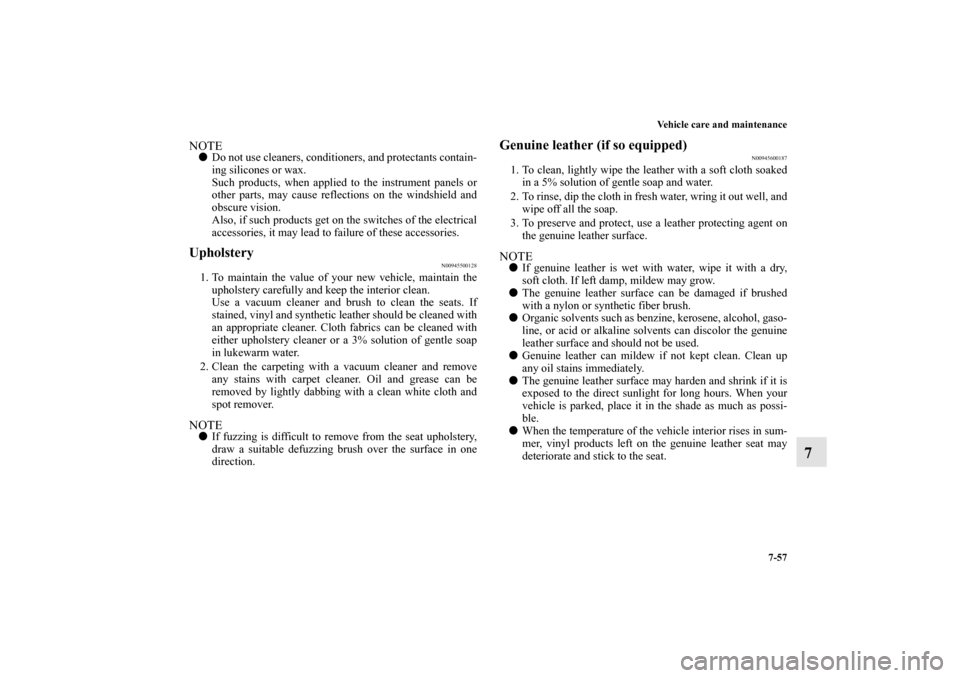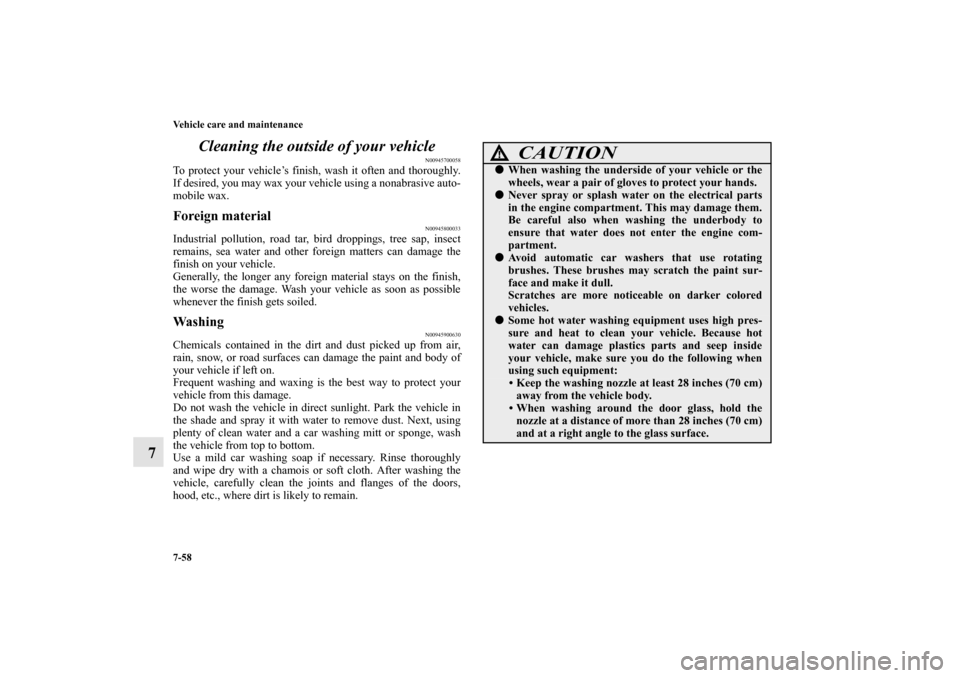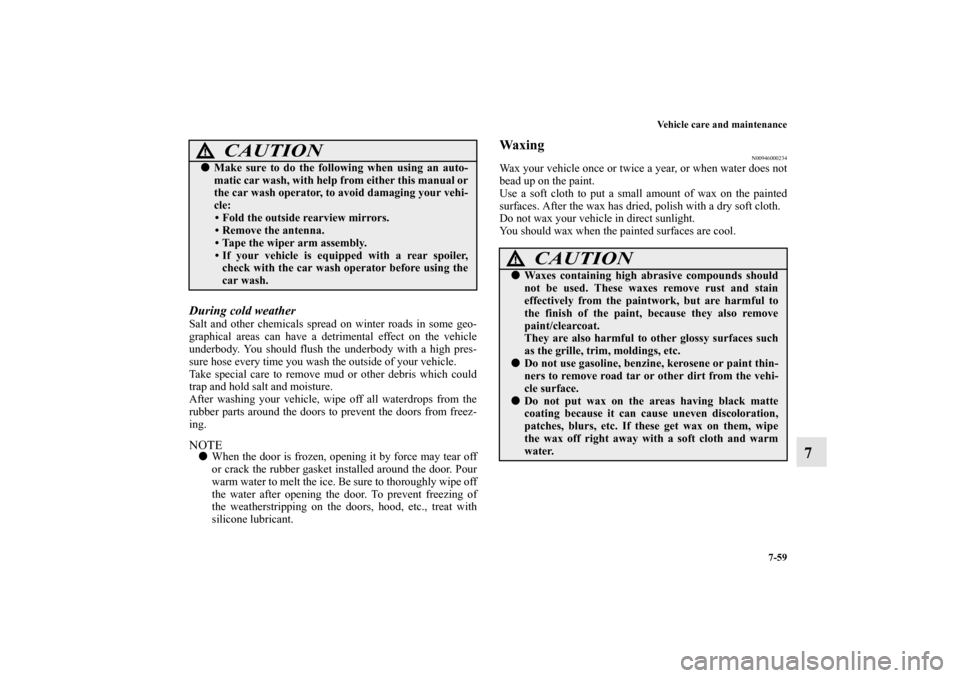Page 425 of 460
Vehicle care and maintenance
7-51
7
5. To install the bulb, perform the removal steps in reverse.NOTE�When refitting each of the clips, first insert part (F) of the
clip into the hole and then press part (G) into it.
Rear combination lights
N00943700490
1. Open the liftgate.
(Refer to “Liftgate” on page 3-41.)
2. Remove the screws (A) that hold the light unit.
BK0162600US.book 51 ページ 2013年3月22日 金曜日 午後2時41分
Page 426 of 460
7-52 Vehicle care and maintenance
7
3. Move the light unit toward the rear of the vehicle to unfix
the notch (B) and pin (C).4. Turn the socket counterclockwise to remove it.
D- Back-up light
E- Rear turn signal light
F- Rear side-marker light, and tail and stop light
BK0162600US.book 52 ページ 2013年3月22日 金曜日 午後2時41分
Page 428 of 460
7-54 Vehicle care and maintenance
7
License plate light
N00944000403
1. Remove the screws (A) that hold the light unit and remove
the light unit.2. Turn the socket counterclockwise to remove it.
BK0162600US.book 54 ページ 2013年3月22日 金曜日 午後2時41分
Page 430 of 460
7-56 Vehicle care and maintenance
7
These can all be dangerous, and they all can damage your vehi-
cle.
Cleaning the inside of your vehicle
N00945200095
After washing the inside of your vehicle with any cleaner, wipe
it dry in a shady, well ventilated area.NOTE�Always read the instructions on the cleaner label.Plastic, vinyl leather, fabric and flocked parts
N00945300142
1. Lightly wipe these off with a soft cloth soaked in a 3%
solution of gentle soap and water.
2. To rinse, dip the cloth in fresh water, wring it out well, and
wipe off all the soap.
CAUTION
!�Do not use organic substances (solvents, benzine,
kerosene, alcohol, gasoline, etc.) or alkaline or acidic
solutions.
These chemicals can cause discoloring, staining or
cracking of the surface.
If you use cleaners or polishing agents, make sure
their ingredients do not include the substances men-
tioned above.
BK0162600US.book 56 ページ 2013年3月22日 金曜日 午後2時41分
Page 431 of 460

Vehicle care and maintenance
7-57
7
NOTE�Do not use cleaners, conditioners, and protectants contain-
ing silicones or wax.
Such products, when applied to the instrument panels or
other parts, may cause reflections on the windshield and
obscure vision.
Also, if such products get on the switches of the electrical
accessories, it may lead to failure of these accessories.Upholstery
N00945500128
1. To maintain the value of your new vehicle, maintain the
upholstery carefully and keep the interior clean.
Use a vacuum cleaner and brush to clean the seats. If
stained, vinyl and synthetic leather should be cleaned with
an appropriate cleaner. Cloth fabrics can be cleaned with
either upholstery cleaner or a 3% solution of gentle soap
in lukewarm water.
2. Clean the carpeting with a vacuum cleaner and remove
any stains with carpet cleaner. Oil and grease can be
removed by lightly dabbing with a clean white cloth and
spot remover.NOTE�If fuzzing is difficult to remove from the seat upholstery,
draw a suitable defuzzing brush over the surface in one
direction.
Genuine leather (if so equipped)
N00945600187
1. To clean, lightly wipe the leather with a soft cloth soaked
in a 5% solution of gentle soap and water.
2. To rinse, dip the cloth in fresh water, wring it out well, and
wipe off all the soap.
3. To preserve and protect, use a leather protecting agent on
the genuine leather surface.NOTE�If genuine leather is wet with water, wipe it with a dry,
soft cloth. If left damp, mildew may grow.
�The genuine leather surface can be damaged if brushed
with a nylon or synthetic fiber brush.
�Organic solvents such as benzine, kerosene, alcohol, gaso-
line, or acid or alkaline solvents can discolor the genuine
leather surface and should not be used.
�Genuine leather can mildew if not kept clean. Clean up
any oil stains immediately.
�The genuine leather surface may harden and shrink if it is
exposed to the direct sunlight for long hours. When your
vehicle is parked, place it in the shade as much as possi-
ble.
�When the temperature of the vehicle interior rises in sum-
mer, vinyl products left on the genuine leather seat may
deteriorate and stick to the seat.
BK0162600US.book 57 ページ 2013年3月22日 金曜日 午後2時41分
Page 432 of 460

7-58 Vehicle care and maintenance
7Cleaning the outside of your vehicle
N00945700058
To protect your vehicle’s finish, wash it often and thoroughly.
If desired, you may wax your vehicle using a nonabrasive auto-
mobile wax.Foreign material
N00945800033
Industrial pollution, road tar, bird droppings, tree sap, insect
remains, sea water and other foreign matters can damage the
finish on your vehicle.
Generally, the longer any foreign material stays on the finish,
the worse the damage. Wash your vehicle as soon as possible
whenever the finish gets soiled.Wa s h i n g
N00945900630
Chemicals contained in the dirt and dust picked up from air,
rain, snow, or road surfaces can damage the paint and body of
your vehicle if left on.
Frequent washing and waxing is the best way to protect your
vehicle from this damage.
Do not wash the vehicle in direct sunlight. Park the vehicle in
the shade and spray it with water to remove dust. Next, using
plenty of clean water and a car washing mitt or sponge, wash
the vehicle from top to bottom.
Use a mild car washing soap if necessary. Rinse thoroughly
and wipe dry with a chamois or soft cloth. After washing the
vehicle, carefully clean the joints and flanges of the doors,
hood, etc., where dirt is likely to remain.
CAUTION
!�When washing the underside of your vehicle or the
wheels, wear a pair of gloves to protect your hands.�Never spray or splash water on the electrical parts
in the engine compartment. This may damage them.
Be careful also when washing the underbody to
ensure that water does not enter the engine com-
partment.�Avoid automatic car washers that use rotating
brushes. These brushes may scratch the paint sur-
face and make it dull.
Scratches are more noticeable on darker colored
vehicles.�Some hot water washing equipment uses high pres-
sure and heat to clean your vehicle. Because hot
water can damage plastics parts and seep inside
your vehicle, make sure you do the following when
using such equipment:
• Keep the washing nozzle at least 28 inches (70 cm)
away from the vehicle body.
• When washing around the door glass, hold the
nozzle at a distance of more than 28 inches (70 cm)
and at a right angle to the glass surface.
BK0162600US.book 58 ページ 2013年3月22日 金曜日 午後2時41分
Page 433 of 460

Vehicle care and maintenance
7-59
7
During cold weatherSalt and other chemicals spread on winter roads in some geo-
graphical areas can have a detrimental effect on the vehicle
underbody. You should flush the underbody with a high pres-
sure hose every time you wash the outside of your vehicle.
Take special care to remove mud or other debris which could
trap and hold salt and moisture.
After washing your vehicle, wipe off all waterdrops from the
rubber parts around the doors to prevent the doors from freez-
ing.NOTE�When the door is frozen, opening it by force may tear off
or crack the rubber gasket installed around the door. Pour
warm water to melt the ice. Be sure to thoroughly wipe off
the water after opening the door. To prevent freezing of
the weatherstripping on the doors, hood, etc., treat with
silicone lubricant.
Waxing
N00946000234
Wax your vehicle once or twice a year, or when water does not
bead up on the paint.
Use a soft cloth to put a small amount of wax on the painted
surfaces. After the wax has dried, polish with a dry soft cloth.
Do not wax your vehicle in direct sunlight.
You should wax when the painted surfaces are cool.
�Make sure to do the following when using an auto-
matic car wash, with help from either this manual or
the car wash operator, to avoid damaging your vehi-
cle:
• Fold the outside rearview mirrors.
• Remove the antenna.
• Tape the wiper arm assembly.
• If your vehicle is equipped with a rear spoiler,
check with the car wash operator before using the
car wash.CAUTION
!
CAUTION
!�Waxes containing high abrasive compounds should
not be used. These waxes remove rust and stain
effectively from the paintwork, but are harmful to
the finish of the paint, because they also remove
paint/clearcoat.
They are also harmful to other glossy surfaces such
as the grille, trim, moldings, etc.�Do not use gasoline, benzine, kerosene or paint thin-
ners to remove road tar or other dirt from the vehi-
cle surface.�Do not put wax on the areas having black matte
coating because it can cause uneven discoloration,
patches, blurs, etc. If these get wax on them, wipe
the wax off right away with a soft cloth and warm
water.
BK0162600US.book 59 ページ 2013年3月22日 金曜日 午後2時41分
Page 434 of 460

7-60 Vehicle care and maintenance
7
Polishing
N00946100046
If painted surfaces have been severely damaged and lost their
original luster and color tone, polish the surface lightly with a
fine polishing compound. Avoid limiting your polishing to the
damaged surface only; polish a somewhat wider area, moving
the polishing cloth in one direction. After polishing, flush the
compound from the surface and apply a coat of wax to regain a
beautiful luster.Damaged paint
N00946200092
Small cracks and scratches in the paint coat should be touched
up as soon as possible with touch-up paint to prevent corrosion.
Check body areas facing the road or the tires carefully for dam-
age to the paint caused by flying stones, etc. The paint code
number for your vehicle can be found on the vehicle informa-
tion code plate on the front passenger door sill.
Cleaning plastic parts
N00946300194
Use a sponge or chamois to clean these parts.
If a vehicle wax sticks to a gray or black rough surface of the
bumper, molding or lights, the surface may appear white in
color. In this case, wipe it off using lukewarm water and a soft
cloth or chamois.Chrome parts
N00946400052
To prevent spots and corrosion of chrome parts, wash with
water, dry thoroughly, and apply a nonabrasive automotive
wax. If the chrome is severely damaged or pitted, use a com-
mercially available chrome polish.
CAUTION
!�Do not use a scrubbing brush or other rough scrub-
ber as these may damage the plastic surface.�Do not use wax containing compounds (polishing
powder) which may damage the plastic surface.�Do not let plastic parts get soiled with gasoline, oil,
brake fluids, engine oils, greases, paint thinner, and
sulfuric acid (battery electrolyte), as such substances
will cause stains, cracks, or discoloration.
If any of these get on a plastic part, wipe them up
with a soft cloth or chamois and a mild solution of
soap and water. Then rinse them immediately with
water.
BK0162600US.book 60 ページ 2013年3月22日 金曜日 午後2時41分